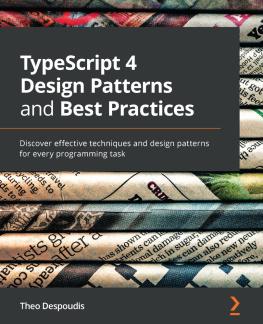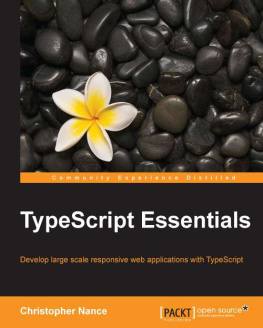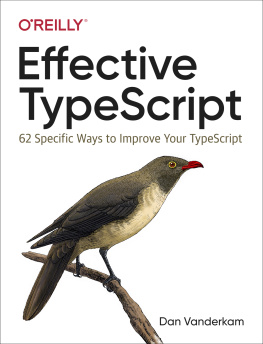Vlad Riscutia - Programming with Types: Examples in TypeScript
Here you can read online Vlad Riscutia - Programming with Types: Examples in TypeScript full text of the book (entire story) in english for free. Download pdf and epub, get meaning, cover and reviews about this ebook. publisher: Manning Publications, genre: Computer. Description of the work, (preface) as well as reviews are available. Best literature library LitArk.com created for fans of good reading and offers a wide selection of genres:
Romance novel
Science fiction
Adventure
Detective
Science
History
Home and family
Prose
Art
Politics
Computer
Non-fiction
Religion
Business
Children
Humor
Choose a favorite category and find really read worthwhile books. Enjoy immersion in the world of imagination, feel the emotions of the characters or learn something new for yourself, make an fascinating discovery.
- Book:Programming with Types: Examples in TypeScript
- Author:
- Publisher:Manning Publications
- Genre:
- Rating:4 / 5
- Favourites:Add to favourites
- Your mark:
- 80
- 1
- 2
- 3
- 4
- 5
Programming with Types: Examples in TypeScript: summary, description and annotation
We offer to read an annotation, description, summary or preface (depends on what the author of the book "Programming with Types: Examples in TypeScript" wrote himself). If you haven't found the necessary information about the book — write in the comments, we will try to find it.
Programming with Types: Examples in TypeScript — read online for free the complete book (whole text) full work
Below is the text of the book, divided by pages. System saving the place of the last page read, allows you to conveniently read the book "Programming with Types: Examples in TypeScript" online for free, without having to search again every time where you left off. Put a bookmark, and you can go to the page where you finished reading at any time.
Font size:
Interval:
Bookmark:

For online information and ordering of this and other Manning books, please visit www.manning.com. The publisher offers discounts on this book when ordered in quantity. For more information, please contact
Special Sales Department Manning Publications Co. 20 Baldwin Road PO Box 761 Shelter Island, NY 11964 Email: orders@manning.com2020 by Manning Publications Co. All rights reserved.
No part of this publication may be reproduced, stored in a retrieval system, or transmitted, in any form or by means electronic, mechanical, photocopying, or otherwise, without prior written permission of the publisher.
Many of the designations used by manufacturers and sellers to distinguish their products are claimed as trademarks. Where those designations appear in the book, and Manning Publications was aware of a trademark claim, the designations have been printed in initial caps or all caps.
 Recognizing the importance of preserving what has been written, it is Mannings policy to have the books we publish printed on acid-free paper, and we exert our best efforts to that end. Recognizing also our responsibility to conserve the resources of our planet, Manning books are printed on paper that is at least 15 percent recycled and processed without the use of elemental chlorine.
Recognizing the importance of preserving what has been written, it is Mannings policy to have the books we publish printed on acid-free paper, and we exert our best efforts to that end. Recognizing also our responsibility to conserve the resources of our planet, Manning books are printed on paper that is at least 15 percent recycled and processed without the use of elemental chlorine.
 | Manning Publications Co.20 Baldwin RoadPO Box 761Shelter Island, NY 11964 |
ISBN 9781617296413
Printed in the United States of America
To my wife, Diana, for her infinite patience
Programming with Types is the culmination of multiple years of learning about type systems and software correctness, distilled into a practical book with real-world applications.
Ive always liked learning how to write better code, but if I were to point out exactly when I started down this path, Id say it was 2015. I was switching teams at that point and wanted to get up to speed on modern C++. I started watching C++ conference videos, picked up Alexander Stepanovs books on generic programming, and gained a completely different perspective on how to write code.
In parallel, I was learning Haskell in my spare time and working my way through the advanced features of its type system. Programming in a functional language makes it obvious how some of the features taken for granted in such languages get adopted by more mainstream languages as time goes by.
I read several books on the topic, from Stepanovs Elements of Programming and From Mathematics to Generic Programming to Bartosz Milewskis Category Theory for Programmers and Benjamin Pierces Types and Programming Languages. As you might be able to tell from the titles, these books are more on the theoretical/mathematical side. While learning more about type systems, I could tell that the code I was writing at work became better. There is a direct link between the more theoretical realm of type system design and the day-to-day production software. This isnt a revolutionary discovery: fancy type system features exist to address real-world problems.
I realized that not every practicing programmer has the time and patience to read dense books with mathematical proofs. On the other hand, my time wasnt wasted reading such books: they made me a better software engineer. I figured there is room for a book that covers type systems and the benefits they provide more informally, focusing on practical applications anyone can use in their day job.
Programming with Types aims to provide a walk-through of type system features starting from basic types, covering function types and subtyping, OOP, generic programming, and higher kinded types such as functors and monads. Instead of focusing on the theory behind these features, I describe each one of them in terms of practical applications. The book shows how and when to use each of these features to improve your code.
The code samples were originally supposed to be in C++. The C++ type system is powerful and more feature-rich than languages such as Java and C#. On the other hand, C++ is a complex language, and I didnt want to limit the audience of the book, so I decided to use TypeScript instead. TypeScript has a powerful type system too, but its syntax is more accessible, so it should be easy to work through most examples even if youre coming from another language. Appendix B provides a quick cheat sheet for the subset of TypeScript used in this book.
I hope you enjoy reading this book and learn some new techniques that you can apply to your projects right away.
First, I want to thank my family for their support and understanding. My wife, Diana, and my daughter, Ada, were with me every step of the way, giving me all the encouragement and space I needed to complete this book.
Writing a book is most definitely a team effort. Im grateful for Michael Stephens initial feedback, which helped shape the book into what you are reading today. I want to thank my editor, Elesha Hyde, for all her help, advice, and feedback. Thanks to Mike Shepard for reviewing every chapter and keeping me honest. Also, thanks to German Gonzales for going through each and every code sample and making sure that everything works as described. I want to thank all reviewers for taking their time and providing invaluable feedback. Thanks to Viktor Bek, Roberto Casadei, Ahmed Chicktay, John Corley, Justin Coulston, Theo Despoudis, David DiMaria, Christopher Fry, German Gonzalez-Morris, Vipul Gupta, Peter Hampton, Clive Harber, Fred Heath, Ryan Huber, Des Horsley, Kevin Norman D. Kapchan, Jose San Leandro, James Liu, Wayne Mather, Arnaldo Gabriel Ayala Meyer, Riccardo Noviello, Marco Perone, Jermal Prestwood, Borja Quevedo, Domingo Sebastin Sastre, Rohit Sharm, and Greg Wright.
I want to thank my colleagues and mentors for everything they taught me. As I was learning about leveraging types to improve our codebase, I was lucky to have some great, supportive managers. Thanks to Mike Navarro, David Hansen, and Ben Ross for your trust.
Thanks to the whole C++ community from which I learned so much and especially to Sean Parent for his inspiring talks and his great advice.
Programming with Types aims to show how you can use type systems to write better, safer code. Although most books discussing type systems focus on more formal aspects, this book takes a pragmatic approach. It contains numerous examples, applications, and scenarios that you will encounter in your day job.
This book is for practicing programmers who want to learn more about how type systems work and how to use them to improve code quality. You should have some experience using an object-oriented language such as Java, C#, C++, or JavaScript/ TypeScript. You should also have some minimum software design experience. Although the book will provide various techniques for writing robust, composable, and better-encapsulated code, it assumes that you know why these properties are desirable.
Font size:
Interval:
Bookmark:
Similar books «Programming with Types: Examples in TypeScript»
Look at similar books to Programming with Types: Examples in TypeScript. We have selected literature similar in name and meaning in the hope of providing readers with more options to find new, interesting, not yet read works.
Discussion, reviews of the book Programming with Types: Examples in TypeScript and just readers' own opinions. Leave your comments, write what you think about the work, its meaning or the main characters. Specify what exactly you liked and what you didn't like, and why you think so.









